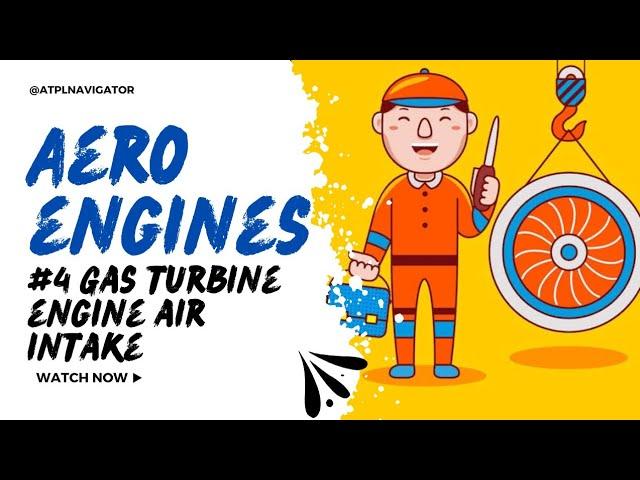
ATPL Training Gas Turbine Engines #04 Air Intakes
**Air Intake in Aeroengines: Optimizing Performance and Efficiency**
The air intake is a critical component of aeroengines, playing a pivotal role in ensuring optimal performance and efficiency. This summary provides an overview of the significance, design principles, and functions of air intake systems in aeroengines.
**1. Significance of Air Intake:**
- **Airflow Requirement:** The air intake is the entry point for the crucial airflow needed for combustion within the engine. Efficient air intake is essential for sustaining combustion, generating thrust, and maintaining engine performance.
**2. Design Principles:**
- **Inlet Design:** The design of the air intake inlet is crucial for capturing and directing incoming air. Inlets are designed to ensure smooth, uniform airflow, minimizing turbulence and pressure variations.
- **Aerodynamic Considerations:** The shape and contour of the air intake are carefully designed to enhance aerodynamic efficiency. This involves considering factors like airspeed, altitude, and angle of attack.
**3. Functions of Air Intake:**
- **Air Filtration:** Air intakes incorporate filtration systems to remove contaminants and particles from incoming air. Clean air is essential for preventing engine damage and maintaining efficiency.
- **Pressure Recovery:** Efficient air intakes aim to recover as much dynamic pressure as possible. This pressure recovery contributes to increased engine performance by providing a higher pressure ratio for compression.
**4. Variable Geometry Intakes:**
- **Adjusting to Flight Conditions:** Some advanced air intake systems feature variable geometry. These systems can adjust the inlet size and shape based on changing flight conditions, optimizing performance across various speeds and altitudes.
**5. Considerations for High-Speed Aircraft:**
- **Supersonic Inlets:** High-speed aircraft operating in supersonic or hypersonic regimes employ specialized supersonic inlets. These inlets manage the shockwaves associated with high-speed flight, allowing for efficient compression.
**6. Impact on Overall Engine Efficiency:**
- **Efficiency Gains:** Well-designed air intakes contribute to overall engine efficiency. By ensuring a steady and clean airflow, they enhance combustion efficiency and facilitate better fuel utilization.
**7. Challenges and Advances:**
- **Boundary Layer Ingestion:** Boundary layer ingestion, where the engine intakes air that has already passed over the aircraft's surface, is a challenge. Research and development focus on mitigating its impact to improve overall performance.
- **Stealth Technology:** In military applications, air intakes are designed to minimize radar cross-section and enhance stealth capabilities.
In conclusion, the air intake in aeroengines is a crucial component that directly influences the engine's efficiency and performance. Through careful design, aerodynamic considerations, and innovative technologies, air intake systems continue to evolve, contributing to the advancement of aviation and aeronautical engineering.
The air intake is a critical component of aeroengines, playing a pivotal role in ensuring optimal performance and efficiency. This summary provides an overview of the significance, design principles, and functions of air intake systems in aeroengines.
**1. Significance of Air Intake:**
- **Airflow Requirement:** The air intake is the entry point for the crucial airflow needed for combustion within the engine. Efficient air intake is essential for sustaining combustion, generating thrust, and maintaining engine performance.
**2. Design Principles:**
- **Inlet Design:** The design of the air intake inlet is crucial for capturing and directing incoming air. Inlets are designed to ensure smooth, uniform airflow, minimizing turbulence and pressure variations.
- **Aerodynamic Considerations:** The shape and contour of the air intake are carefully designed to enhance aerodynamic efficiency. This involves considering factors like airspeed, altitude, and angle of attack.
**3. Functions of Air Intake:**
- **Air Filtration:** Air intakes incorporate filtration systems to remove contaminants and particles from incoming air. Clean air is essential for preventing engine damage and maintaining efficiency.
- **Pressure Recovery:** Efficient air intakes aim to recover as much dynamic pressure as possible. This pressure recovery contributes to increased engine performance by providing a higher pressure ratio for compression.
**4. Variable Geometry Intakes:**
- **Adjusting to Flight Conditions:** Some advanced air intake systems feature variable geometry. These systems can adjust the inlet size and shape based on changing flight conditions, optimizing performance across various speeds and altitudes.
**5. Considerations for High-Speed Aircraft:**
- **Supersonic Inlets:** High-speed aircraft operating in supersonic or hypersonic regimes employ specialized supersonic inlets. These inlets manage the shockwaves associated with high-speed flight, allowing for efficient compression.
**6. Impact on Overall Engine Efficiency:**
- **Efficiency Gains:** Well-designed air intakes contribute to overall engine efficiency. By ensuring a steady and clean airflow, they enhance combustion efficiency and facilitate better fuel utilization.
**7. Challenges and Advances:**
- **Boundary Layer Ingestion:** Boundary layer ingestion, where the engine intakes air that has already passed over the aircraft's surface, is a challenge. Research and development focus on mitigating its impact to improve overall performance.
- **Stealth Technology:** In military applications, air intakes are designed to minimize radar cross-section and enhance stealth capabilities.
In conclusion, the air intake in aeroengines is a crucial component that directly influences the engine's efficiency and performance. Through careful design, aerodynamic considerations, and innovative technologies, air intake systems continue to evolve, contributing to the advancement of aviation and aeronautical engineering.
Тэги:
##AirIntake ##Aeroengines ##EnginePerformance ##AerodynamicEfficiency ##InletDesign ##AirflowOptimization ##AirFiltration ##PressureRecovery ##VariableGeometryIntakes ##SupersonicInlets ##BoundaryLayerIngestion ##StealthTechnology ##AerospaceEngineering ##FlightConditions ##EfficiencyGains ##AviationTechnology ##AircraftPropulsion ##HighSpeedAircraft ##EngineDesign ##InnovationInAerospaceКомментарии:
ATPL Training Gas Turbine Engines #04 Air Intakes
ATPL Navigator
How To Showcase Your Real Estate Listings With A Carousel (Ad) Style Facebook Page Post
Lowell Brown | Going Social
32 VS 64 BITS
Léo - TechMaker
Real Estate Marketing Ideas 2023
Mohit Sharma
SCRIM "TRAINING CAMP" by Pasopati Esports #37 match 1
Pasopati Esports


























